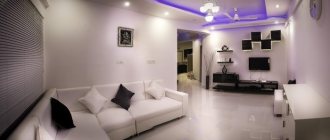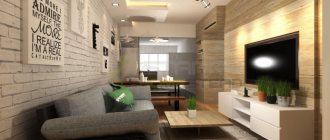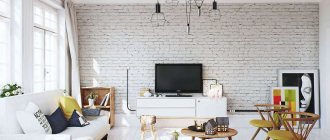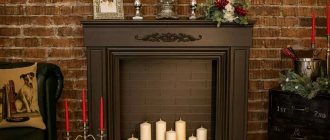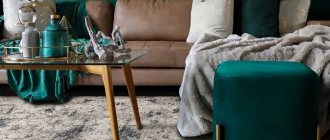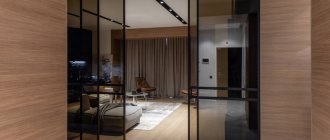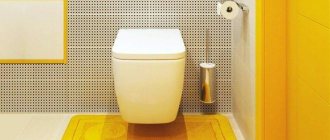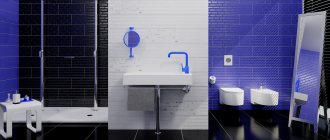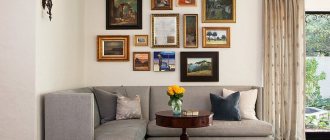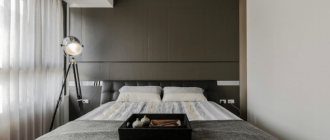Many designers like to use such a feature as an “Accent Wall” in their work. Even without explaining the meaning of this term, on an intuitive level, it still becomes clear what we are talking about. An accent wall is a wall that is significantly different from the rest of the walls in the room and attracts attention due to its unusual texture, bright color or pattern.
This trick is designed for the “wow” effect and almost all designers love to use it in order to attract additional attention. It has been scientifically proven that a person’s impression of his location is formed in a quarter of a minute, and everything he sees after this time is perceived by the brain under the yoke of the first impression.
A reception with an emphasis on one of the walls of the room not only serves to attract the first glance of the guest, it can serve as a decoration with an original design solution. Its function depends on the type of accent. In this way, you can visually change the room to increase the space, narrow it, highlight bright decorative elements or architectural features of the room.
Let's figure out in what cases it is appropriate to make an accent wall and consider some rules. Let's see in which rooms it is most appropriate to use this technique, and what are the rules for the correct placement of the accent.
Why is it stylish and fashionable?
Today, many create apartment designs using this technique, but what is the reason for such popularity?
- An emphasis on one wall in the interior visually corrects the room and eliminates its shortcomings - it will make a narrow room wider, a long one shorter.
- Creating an accent wall energizes the apartment and brings it to life. The finish looks more textured.
- The use of different colors and textures zones multifunctional rooms.
- The distinctive plane itself is a decorative element and helps to save on additional accessories.
Highlighting the plot
There is an opportunity to kill two birds with one stone: highlight a wall, ridding the interior of flat impersonality, and introduce a thematic component into the room. To solve these problems, photo wallpapers are usually used.
If an accent wall is created using photo wallpaper, the decor in the room should be kept to a minimum. And the palette should be quite meager. Otherwise, it will be difficult to avoid some redundancy that tires the eye.
How to choose a subject for an accent wall? If you don’t want to introduce an additional theme, you can settle on a neutral subject - for example, an image of plants. To emphasize the modern urban essence of the interior, use photo wallpaper with a fragment of a city street or building. If you want to emphasize the “pastoral” nature of the interior, choose photo wallpapers with a natural or rural theme.
In addition to photo wallpaper, there are other options for highlighting the subject. For example, an accent wall can be covered with... a geographical map. This will support the theme of distant travels present in the interior.
A more expensive and incomparably beautiful way to create a thematic accent wall is a story painting, a fresco.
Our article “Photowallpaper in the living room interior” will help you choose a theme for an accent wall.
What materials are they made from?
Basic materials for decorating an accent wall:
- Wallpaper. In order not to overload the interior, where there are already drawings on the surfaces, use plain canvases. They can also be glued to plain “neighbors”, only by choosing a contrasting color. Wallpaper with large or small patterns will perfectly complement plain ones.
- Dye. The principles of compatibility are repeated with wallpaper - cover the surface with one color, create a print or draw graffiti. Another option is slate paint, which you can draw on with chalk.
- Photo wallpaper. From a huge range of themes you will definitely find something that suits your bedroom, living room or kitchen. Abstraction, 3D effect and panoramas look the most interesting.
- Tile. As with paint and wallpaper, use a contrasting solid color or pattern. Its use is justified in the bathroom, toilet, and kitchen.
- Panels. Plastic, plaster, glass, fabric, foam - the choice of materials from which they are made is huge. Whatever you choose, this is one of the easiest ways to get high-quality results.
- Stone. This includes both natural material and its imitation or porcelain stoneware. Most often used in wet areas, corridors.
The photo shows the use of red brick in decoration
- Brick. The most popular options are red or white, but a brick wall can be painted in absolutely any color.
- Concrete. An unusual texture for a loft can be obtained from decorative cement.
- Tree. Recently, laminate or parquet laid vertically has become popular, but slats or panels will also create an accent.
- Plants. Phytowalls are becoming increasingly popular as an easy way to get an unusual and useful decoration.
- Decorative plaster. Add texture to the wall and cover the top with any paint.
The last option does not relate to decoration, but we cannot help but mention it: furniture. Adding an unusual cabinet or shelving unit can also help create an accent wall.
How soft panels are created
Manufacturers of building materials have launched the production of soft wall panels. However, there are craftsmen who assemble and install coatings with their own hands. The warm finishing panel consists of 3 layers:
- The basis. It is created from durable sheet materials from wood to lightweight plastic with a thickness of 5–7 cm.
- Filler. This is the middle layer, consisting of affordable materials, from foam rubber and synthetic padding to foam chips or polyurethane.
- Tight. It is selected according to the taste and financial capabilities of the customer; a variety of elastic materials of the highest quality are used as the top layer.
Important point! The covering is always treated with special compounds that provide protection from sunlight and high temperatures, and also give the top layer water-repellent properties.
Craftsmen assemble a variety of wall panels and attach them with glue. There are modern soft coverings on the construction market that are sold with components. It is recommended to pre-prime the walls twice, and then build a sheathing onto which the wall panels are attached using special locks.
Which color is better to choose?
There are three color options - contrasting is lighter, contrasting is darker and matches the other surfaces, but with an ornament.
- Lighter means if the rest of the space is dark, then the accent will be white, beige, gray and any other neutral color.
- Darker - on the contrary, dark and bright colors will appear as a spot on a light background.
- To match - a green accent wall in a green space, white with pink flowers in pink.
The color palette also affects the perception of space:
- warm or dark shades bring objects closer;
- cold or light - they move away.
In the photo, the area behind the bed is highlighted
Choose a contrasting shade using the color wheel. He will also suggest harmonious combinations. There are 3 schemes for combining two colors:
- In front of each other. These are the most active pairs: yellow+violet, orange+blue, red+green.
- On the side. Minimally extravagant pairs are yellow + green, blue + purple, red + orange.
- From below. The closer to the center, the lighter the shades. That is, combine the same color, but with different degrees of brightness.
Photo wallpaper
The idea is not new, but images in calm colors are now in fashion, even if they are landscapes or city landmarks. The point of such a finish is not brightness, but unusualness, but it’s still better to think carefully before choosing such a canvas. You have to live with him for more than one day or even one month.
Photo: noviydom.com.ua
What texture or pattern would work?
Finishing the topic of color, it should be noted: the accent wall in the interior can be the same tone as the others, but its texture should highlight it. The most winning option in this case is a combination of opposites. Smooth with embossed, plain with patterned, warm with cold. For example, paint with brick, plain wallpaper with patterns, stone or paint with wood.
The photo shows an imitation of the texture of stone
When choosing printed finishing materials, you should remember various visual effects:
- horizontal stripes expand space, use them on short sides in narrow rectangular rooms;
- vertical lines raise the ceiling, suitable for low rooms;
- A small floral pattern increases the space, a large one reduces it. Any flowers soften the surrounding interior;
- wallpaper with small spots and dots evens out the walls and hides their defects;
- geometric prints set the rhythm and, depending on the color and size, also influence the perception of the room. They add brutality.
Philosophy of gold
Wallpaper in golden shades in the interior is created for special homes. After all, the philosophical meaning gives gold a truly impressive set of qualities. In the religious community, it is customary to consider the golden light to be a symbol of spiritual enlightenment, pouring out truth from the very source. Those who always carry gold with them or are surrounded by gold elements are endowed with wisdom, beauty and success.
When decorating your interior with gold wallpaper, you will never be visited by apathy, depression or other negative aspects. On the contrary, the environment will always radiate vibrations of joy. A person in such an atmosphere will be endowed with a good positive mood, a desire to live and conquer new heights.
Which wall should I use as an accent wall?
The accent wall in the interior should be visible when entering the room, so it is best if it is located opposite the door.
In the living room, the space behind the sofa or TV is used. The same applies to the bedroom - behind the head of the bed, or opposite it. At the entrance, two accent walls are often made, highlighting the area with the door and adjacent to it.
In the photo there is a decoration made of gypsum blocks
The choice also depends on the geometric shape. In narrow, elongated rooms, you should not emphasize the long sides. On the contrary, a short black accent wall with or without a window helps to visually align the space.
Partial decor of an accent wall is used for zoning - using a narrow stripe, a dining or work table, a TV, or a shower stall are highlighted.
The photo shows a panel made of wooden hexagons
Luxurious laconicism
In this bright space, two points of attraction compete with each other - a bio-fireplace against the backdrop of a luxurious marble slab in a butterfly layout and a TV panel. The architect made them friends by placing them on adjacent walls. At the same time, the fireplace remains a powerful aesthetic dominant of the living room.
Apartment in one of the modern residential complexes in Moscow, living room. Authors of the project: Alexandra Fedorova, Sergey Kalyuta, Irina Gubskaya. Photo: Ilya Ivanov.
Apartment in one of the modern residential complexes in Moscow, living room. Authors of the project: Alexandra Fedorova, Sergey Kalyuta, Irina Gubskaya. Photo: Ilya Ivanov.
Ideas in the interior of rooms
Materials and techniques depend on the purpose of the premises in the apartment.
Accent wall in the living room
We have already mentioned that most often the space is allocated behind the sofa or TV.
In the photo there is a black and white mural behind the sofa
Do not choose too bright, flashy designs or shades that match the plasma, otherwise watching TV shows will be uncomfortable. Behind the seats, on the contrary, you can experiment with the design, because you will not see this area while you are in the hall.
Accent wall in the bedroom
Decorate the entire area behind the bed in a small room or cover the width of the headboard in a large one. In the second case, soft or wooden panels, as well as other headboard options for the ceiling, look original.
The photo shows an example of an accent wall in a bright bedroom
If the surface has a texture, lighting from below or above will allow you to achieve an interesting effect and emphasize the texture.
Photo of an accent wall in the kitchen
The most practical solution is a kitchen apron of full width and height. It is mainly made from tiles, but panels, stone, and brick are also suitable.
In the photo there is an apron across the entire width of the wall in the kitchen
The second possible area is the dining area. Different decoration around the table zones the room.
Children's room interior with accent wall
There are practically no rules in decorating a child's or teenager's room. Use the decor for education (geographical maps for a schoolchild, pictures with letters and numbers for a child), entertainment (black and white coloring or slate surface) or decoration (3D wallpaper, photo wallpaper with characters from your favorite fairy tales and cartoons).
The photo shows Scandinavian children's wallpaper
How to decorate an accent wall in a bathroom?
Often the emphasis is placed on the sink, toilet or bathtub. In a separate bathroom, decorate behind the toilet, hang bright wallpaper or tiles. When combined, highlight the shower or bathtub with contrasting tiles.
Options for the hallway
An accent wall in a narrow corridor is placed opposite the door and made darker. Or they paint the door itself and everything around it in a deep, monochromatic shade. To decorate a long accent wall in the hallway, use paintings and photographs; this will distract from the irregular geometry of the space.
In the photo there is a corridor in black and white with a slate door
How does yellow (golden) color and its shades affect the psyche?
As you know, the color of gold comes from yellow. What associations do you have with the words: sunflower, sun, smiles? Of course, the following: warmth, summer, good mood, joy, activity. It’s not for nothing that yellow is considered the color of active youth.
If your apartment or room is decorated with this warm and sunny color, it will stimulate the speed of brain processes and decision-making; yellow in the kitchen activates appetite and improves digestion; in the nursery it will help the child to be healthier, more agile and flexible.
But, as with everything, there is a downside. An abundance of yellow, like an abundance of irritants, can tire you and lead to a state of mental and physical exhaustion.
The result can be nervousness, loss of energy and even depression. In addition, yellow, or rather some of its shades, can visually “eat up” space, which is simply destructive for small rooms. Therefore, you need to carefully select shades of yellow and their quantity.
